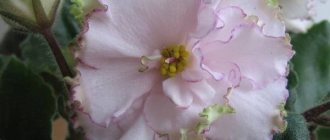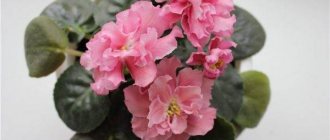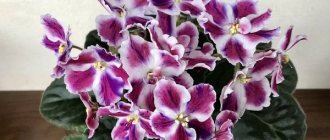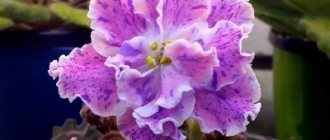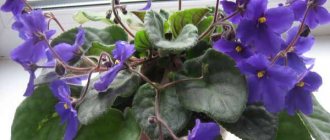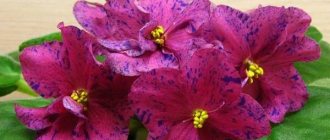The authors who created all the presented varieties are breeders Paul and Sidney Sorano, .
The varieties were bred in the Sorano family's Lyndon Lyon in Dolgeville, New York, USA, which Paul has run since 1982, following the retirement of his grandfather Lyndon Waldo Lion, the founder of the beautiful family business. The described varieties of Saintpaulias of these masters are included in the conventional group with the prefix “Lyon's” and invariably find their admirers among collectors all over the world.
Violet Lyon's Zoe (2013), Paul Sorano
Description of violet
An elegant and strong variety in rich colors represents exhibition variations of Saintpaulia standards with enlarged forms.
From the beginning of its development, the violet independently organizes the bush in spread-out compact contours, which helps it create a neat checkerboard configuration of an adult rosette.
The medium-sized leaves have a heart-shaped oval shape with a neatly pointed tip, a textured quilted dense-glossy layer, a strong jagged edge and frequent venation in the form of a pressed mesh, creating a voluminous tuberosity of the plate.
The configuration of the leaves suggests they are slightly curved like a spoon. The color background of the plates is represented by rich dark tones of malachite. The reverse side has a reddish highlight.
ATTENTION! The highlight of the color scheme of the chic hats is the use of intense shades of the reddish-burgundy palette to color the extremely terry “star” corollas.
The smooth velvety background of the main part of the petals ends with a snow-white braid running along the wavy edges.
in this variety .
Features of maintenance and care
The variety belongs to variations of the genus with simple care and an absolutely non-capricious reaction to its use. The violet has several features that emphasize its magnificence:
- itself ennobles an almost exhibition rosette;
- bears heavy flowers on strong straight peduncles;
- does not change the richness of the shades of the corollas;
- loves to bloom unusually - violently and for a long time.
Violets do not harm the chic decorative effect:
- small folding of leaves into a “boat”;
- lumpy rosette background.
Reviews
Klara Romanovna. “The Lyon's Zoe violet is a real work of art, a royal variety. I advise everyone!"
The remaining varieties belong to the selection of Sidney Sorano.
Violet RS-Temptation
What names were these beautiful flowers called? You can't name everyone.
Genus, family
Violet RS-Soblazn, the photo and description of which is presented in this section, belongs to the hybrids of Uzambara violet :
- Family : Gesneriaceae;
- Genus : Hybrid Saintpaulia (Saintpaulia hybrida).
Origin story
Breeder Svetlana Nikolaevna Repkina . From Lugansk. She worked as a mechanical engineer at a sports equipment manufacturing plant.
Interesting Facts:
- He has been making violets since 1998. Their selection since 2001;
- There are more than two hundred varieties bred. Stores all varieties in several pots. And there are even 20 individual ones;
- The rosette, especially the exhibition one, is very important for violets. And for Svetlana, the main thing is flowers;
- He dreams of developing a variety of Saintpaulia with flowers the size of peonies;
- The most successful selection - from four seedlings four real varieties were obtained;
- Her hobby is her own kennel for breeding German shepherds;
- Her violets have also been exhibited in the USA. I had to register them first.
“The people who love flowers produce beautiful plants. Then the violet will present a miracle - an unusually beautiful bud will bloom and give you bright emotions.” Svetlana Repkina thinks so.
Photo and description of the variety
Socket:
- Standard;
- The oval-shaped green leaves are slightly wavy and quilted. They are notched at the edges;
- The underside of the leaves has a reddish tint;
- The leaves do not always maintain the correct arrangement for a neat rosette. It twists them a little.
Flower:
- Large white semi-double stars. Their sizes are 6-7 cm;
- There are wide lilac-fuchsia prints on the corrugated petals;
- The wavy and fringed edges of the petals are slightly lighter than their middle.
Variegation, imprints
Light lilac prints on white petals just give a special charm to the flowers of Temptation.
Important! Their sizes may vary. If conditions change.
Sports
Flower growers are silent about sports . Maybe they mistake them for the usual variability of violets. From temperature, light. Or don’t want to talk about their omissions?
Features of flowering, growth and reproduction
Without the peculiarities of flowering, there would be no varieties.
Development at home
Its growth and flowering are quite interesting to watch. Even entertaining:
- The beautiful flowers that grow during the first flowering are not so large;
- Their size increases noticeably in the second flowering . Especially after the third one.
How long does it take to grow an adult plant?
From the beginning of rooting of cuttings to beautiful flowers, you at least 9-12 months . There are more.
With good care, you yourself can reduce these times a little.
This is not even a fully grown plant - a starter. But who can say that he is not yet an adult!
How are varietal characteristics transmitted?
To propagate this variety, gardeners often use the vegetative method. It allows you to preserve the maternal qualities of the variety. And not so difficult at home:
- Rooting leaf cuttings;
- Seating the children.
When propagated by seeds, varietal characteristics are not always preserved . It will take more time and effort.
Flowering in hot and cool conditions
For Temptation, cool conditions are more preferable . Temperature fluctuations significantly affect the contrast and brightness of flowering. And the color itself. At high temperatures, flowers can become very dark . And cover all the white parts of the petals. As in the photo below.
What do flower stalks look like?
Strong short peduncles hold large flowers well. And not alone. And they allow you to create a whole hat.
Is it possible to achieve cap flowering?
- The variety forms a beautiful bouquet well . Quite often, flower growers display caps of this variety. And this is with large flowers;
- And they are tempted to purchase this particular variety for their collection of violets;
- Some flower growers have their own opinion: “a beautiful cap of roses on the cake.”
Bud lifespan
Blooming flowers retain an attractive and fresh appearance for a long time . Blooming flowers attract attention more. Than buds.
Violet can delight with new blooms two or three times a year . Many gardeners have this. With proper care and attention.
Reviews
Hope. “I’ve had this sort for a long time. I update it periodically. It’s impossible not to love such huge beautiful flowers. The prints are just right. Both contrasting and do not float. I also like its strong flower stalks. They do not allow even such large flowers to fall.”
Valentin. “Many violet lovers have Svetlana’s varieties. They are suitable for our apartments. Whether on the windowsill or on the shelves. Such is the Temptation. He definitely tempts. Even when you see a good first flowering, this is not the limit. Subsequent ones will be larger. Their color is more saturated. And the bouquet is even more elegant.”
Alexander Petrovich. “Svetlana Repkina is a talent from God! In breeding masterpiece varieties of violets. With very large flowers. It’s not for nothing that she talks about her affection and passion for gigantomania. Temptation is one of this wonderful variety. A very beautiful and reliable variety. It's been quite a long time."
Marina. “I went to an exhibition with the participation of Svetlana herself. I didn't bring anything. I didn't like its sockets. All with long cuttings.”
Violet Lyon's Lavender Magic (2003)
Description of the variety
The violet silhouette is a format that is light in nature, suitable for growing without whims in the collections of all gardeners of a large-standard Saintpaulia : it is independently filled with a dense, tiled volume of leaves, becoming a neat plant with ideally all-round symmetry.
The fleecy-shiny oversized leaves of an elongated heart-shaped structure have a noticeable, medium-distinct serration of contours, textured quilting and clearly outlined graphics of the veins.
The color background of the leaf plates is distinguished by the rich color scheme of darkened grass, and their structure is of sufficient density. The leaf padding has a reddish sheen. The tips of the plates can bend towards the flowerpot.
The hallmark of Saintpaulia is rich caps of extremely large, simple, less often semi-double “star” flowers in structure, the wavy petals of which have fringed frills along the edge. The corollas of the white variety are decorated with large prints in delicate shades of lilac and lavender.
Sports
Saintpaulia is capable of sporting very rarely : it forms corollas with petals that are remarkably corrugated at the edges, wrapped in a tube, and the color of the prints is closer to a violet tone.
Features of development and care
The variety has a relatively calm character ; in cultivation it is distinguished by its unpretentiousness and independence in terms of the design of a large-textured bush.
He is very hardworking and produces multiple buds early . The corollas last for about a month, but their thin stalks can lie on the rosette.
INTERESTING! The temperature of keeping Saintpaulia directly affects the decorative appearance of its caps: the color of the corollas in the heat takes on an even shade of lavender, and the white background of the petals becomes more pronounced the cooler the room.
Reviews
Peter Ionovich. “A significant advantage of the Lyon's Lavender Magic variety is active flowering from the first budding of the specimens.”
Caring for a plant at home
The growing conditions for these two varieties with the same name Temptation are very similar. Even with different socket sizes.
Conditions of detention
Find a suitable location among your flowers . From many options:
- Window sills. They are the most talked about among gardeners. Considering many factors;
- Racks, shelves, stands, hanging flower pots. They will allow you to decorate your entire apartment with such luxurious flowers. And not just window sills.
Proper watering and fertilizing
Watering violets is even a creative process. The main thing is not to overfill it. Soil condition - guideline and graph.
You need to choose the appropriate watering method. Subject to your conditions. And the sizes of each Temptation:
- Watering the soil from above: Using a syringe. Along the edges of the walls;
- Watering cans with a long spout are convenient. This is more for the standard;
- A syringe (without a needle) is also suitable for watering the mini;
- The water from the pan must then be removed. After 10-20 minutes.
- It is very convenient for small plants. The roots gain as much moisture as they need;
- Place a synthetic cord in a ring in the pot. On top of the drainage. Quite often without it. In a container with water it lies at the bottom.
There are many opinions. And serious arguments. We need to listen to them. And decide for yourself.
For many, it is the only way out of life situations. Allows you to be away for 2-3 weeks without any problems for Saintpaulia.
So Kuznetsov’s minis were grown in an original way. Including Temptation.
More options:
- Without a wick, but on capillary mats;
- Or in pallets on a layer of moss. Excess moisture flows into the tray when watering. And it retains additional moisture. The earthen lump does not dry out.
Many gardeners share their watering experiences. They don’t stop at one method:
- For some varieties there is a wick, for others - a tray;
- And for some, watering from above.
Important! Use warm, settled or boiled water. You can add an activated carbon tablet to it.
Make good drainage for violets:
- Many gardeners prefer finely chopped pieces of polystyrene foam. Easy to do. Reliable. No acids or deposits;
- For small violets it is very practical to use coal drainage. Using sphagnum moss. As an alternative to wick. This drainage makes up half the capacity.
Lighting and temperature
Violets need a comfortable temperature to bloom. And good lighting:
- Saintpaulia will need light at least 12 hours a day . Summer and winter;
- Provide protection from the burning rays of the sun : Curtains, drapes, blinds;
- Window sills on the north, east and west sides are well suited for this.
- Flower growers find different solutions: Ordinary natural light is not always enough. In the evening in winter, the lights are turned on;
- In the corridors, bedroom, living room, there is no way to do without additional lighting.
Advice! Turn the shadow sides of violets towards the light. Periodically. The bushes will be compact and uniform.
- For good flowering, are not enough . And above 25 degrees is no longer desirable ;
- Violet flowers become lighter in color at low temperatures. And the prints are getting smaller;
- And in the heat, the white edges swim and lose. As with excessive lighting.
Air humidity
- Violet by nature loves moist air . They grow fully and bloom beautifully;
- But you need to spray it carefully . After flowering. Be sure to let it dry and remove all wet residue from the leaves. Especially from a growth point;
- But drought is contraindicated for her . The leaves are not the same. The flowers are also smallish;
- To increase humidity, you can install containers of water. Or put moistened wipes (foam sponges).
Be mindful of humidity. Especially with very hot radiators.
What kind of soil does he prefer?
Violets will not bloom in poor soil. They need light soil. There are many options for its composition. The substrate must contain:
- Peat (high);
- Perlite;
- Vermiculite;
- River sand;
- Charcoal.
A good basis for high-quality soil can be special soils for Saintpaulias . Stores offer them.
Stores offer a large selection of soils for violets.
Violet requires regular replanting and changing the soil. It all depends on the varietal characteristics and conditions:
- Some people do it immediately after abundant flowering;
- The soil for miniature violets is not updated so often. As for larger ones. Once every one and a half to two years.
A. Kuznetsov’s substrate consisted of peat and perlite.
Pruning and hygiene
Every violet lover strives to grow a beautiful rosette:
- Trim drying leaves and flower stalks . Remove diseased leaves and treat sections with activated carbon;
- Look at the roots when transplanting. And refresh them;
- Regulate the growth of stepchildren. They need to be removed. So that flower stalks appear. Or use it for propagation.
The lower leaves of the mini practically do not turn yellow. They maintain a healthy appearance longer than standard. And they produce excellent flowering.
And this photo will help you cut the leaves correctly. And make a beautiful rosette.
Reproduction methods
Temptation violets multiply:
- By cuttings . They are rooted in different ways: In water (but not the Temptation mini);
- In the ground;
- In peat tablets.
- Children;
- The process of propagation by seeds is longer. But it is used to breed new varieties.
Transplant rules, rejuvenation
Replanting for plants is important and necessary:
- To change to high-quality soil;
- When replacing a container with a larger size;
- As young plants grow from children, 2-3 transplants will be required with a change of container;
- After removing the lower leaves, the stem seems to stretch out. When transplanting, it can be deepened.
The miniature violet needs to be replanted. Some gardeners do this after two or three flowerings.
Violet Lyon's Crown Jewel (1996)
Description of the variety
An impressive two-color retro violet withstands the enlarged gradient of standard scales and has a compact rosette shape with regular silhouette contours that independently manifests itself with age.
The leaves of the middle range in the shape of a smooth, elongated-pointed oval are characterized by a significant voluminous wavy surface of a glossy texture, teeth clearly visible along the contour in the form of a medium-sized wave, an intensely pressed pattern of emerald venation network and juicy malachite coloring of the plates.
The violet forms the volume of contours of stunning caps from “star” flowers with a simple or semi-double corolla structure, whose petals have a slight waviness and sufficient fringe of the edges.
NOTABLE! The color palette of the chimeric corollas of the variety includes a white color of the central radiant stripes and various shades of fuchsia tones of the main background.
The sparkling texture of the petals emphasizes the sophistication of the violet's colors, and the presence of an emerald green edging along the fringe is a varietal accent.
Sports
The violet is noted for its rare display of sporting characteristics, which are expressed in dark foliage and shading on the rays of the chimera.
Features of growth
The attention of flower growers to the vintage violet is due to its light growth and bright silhouette. You can also note:
- the presence of independent and even formation of rosettes;
- the enormity of the caps and the indomitability of the flowering, especially on the wick;
- a large number of stepsons, which is important for reproduction.
To ensure bright colors, specimens should be kept cool in the collection.
Reviews
Lauren. “The retro variety 'Lyon's Crown Jewel' has proven its superiority over a long period of cultivation.”
Growing conditions
Aeschynanthus is considered a finicky plant among gardeners, but if you care for it properly, following all the tips, it will not cause much trouble.
Placement and lighting
Eschananthus Mona Lisa prefers well-lit places, protected from direct sunlight, with diffused light, since sunburn may appear on the leaves. It is best to place it on window sills on the western or eastern side of the house. It is also necessary to provide the plant with long daylight hours; if necessary, it should be additionally illuminated.
Temperature
Like any other tropical plants, this flower is very thermophilic and does not tolerate sudden temperature changes and drafts. In the warm season, it is advisable to keep it at a temperature of +23...+26°C; in winter, the temperature can be slightly reduced to +16...+18°C.
Important! To form buds, the flower must be placed in a cool place, ensuring peace.
When the temperature drops below +15°C, the plant may get sick.
Air humidity
In hot summer weather, Eschynanthus Mona Lisa must be constantly sprayed with a spray bottle (1-2 times a day), without getting on the flowers, or place a container of water next to the flowerpot. In winter there is no need for such humidification, only if the room is very warm. Water for spraying should be at room temperature, settled and soft.
Violet Lyon's Plum Pudding (1995)
Description of the variety
A maturing vintage Saintpaulia independently, carefully but continuously, comes to the silhouette of its spectacularly regular rosette of a standard type with a harmonious arrangement of structural elements.
The shiny leaves of a pointed, wide-oval structure have distinctly rounded jagged contours and lightly pressed graphics of veins with an emerald central axis.
The coloring of the plates is distinguished by a bright shade of lush greenery. Leaves often point upward.
IMPORTANT! Almost the darkest variety.
The corollas of lush, loose bouquets attract attention with velvety shades of plum-violet colors with watercolor tints in ink coloring.
The flowers are large “star” flowers of semi-double and double form, their slightly wavy petals have a ruffled edge texture. The buds are almost black before they bloom.
Instances of the plant do not produce sports.
Content Features
This unpretentious variety has long been widespread among gardeners because:
- captivates with the density of tonality and the splendor of bouquets;
- captivates with hard work;
- has strong peduncles.
The main condition is coolness during the flowering to protect the corollas from light spotting.
Reviews
Yulia Ivanovna. “I love old varieties, they are somehow alive. Such is the violet "Lyon's Plum Pudding" - wondrous perfection.
Botanical description of the plant
The flower's birthplace is considered to be the southeast of Asia, namely the tropical forests of Vietnam, Indonesia, Malaysia, and Thailand. In its natural habitat, it prefers to grow on trees or rocks, twining around them. The plant is considered an evergreen perennial with an exotic appearance.
Did you know? from Greek
as “distorted flower,” and all because the flowers of aeschynanthus look as if they have been turned upside down.
The flowers are curved tubes of bright red color with protruding white stamens, located at the ends of the shoots, bloom from May to September. The stems are long, curly, directed upward, to which shiny leaves of a dark olive color are densely attached.

